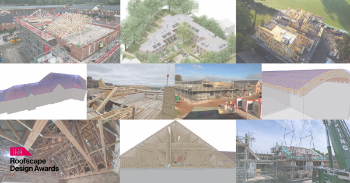Specifying brick

|
Contents |
[edit] Introduction
When specifying brickwork, various criteria should be considered depending on factors such as the intended application, the exposure and the aesthetic effect required.
[edit] Machine- or hand-made
The production process by which bricks are made does not usually affect their in-use performance, whether from the point of view of durability or frost resistance. Whether a stock brick, hand-made or extruded brick is required will, more often than not, depend on the aesthetic effect that is required.
Extruded bricks – so-called because a column of clay is pushed through a die and then cut to size – can give very precise arrises leading to a more mechanical look. They come in a wide range of colours and textures. At one end of this process is the engineering brick which is both smooth, hard and precise, suited to contemporary projects, while at the other end of the spectrum, hand-made bricks are typically more suited to heritage and rural applications.
There are two types of handmade brick – those which really are handmade (ie a clump of clay is thrown manually into a mould, the excess smoothed off and the mould emptied of its contents), and those where the manual process is automated, replicating the hand-thrown process.
[edit] Solid or perforated
Bricks with holes are termed 'perforated' and come in a variety of shapes, size and number: three circular holes is a typical configuration, but perforations can be square or slotted. They are designed to make the brick lighter, use less clay and can result in more even firing. Where necessary, perforations can also be used to house reinforcing rods.
Care has to be taken when specifying. Perforated bricks can be the norm on a project but it is often more prudent to specify solid bricks for applications such as:
- Capping bricks on freestanding walls and steps, otherwise an unsightly holed effect will be visible.
- Where it is necessary to attach fixings into the brickwork, especially for heavy-duty loads.
- Where an acoustic internal partition is required. Frogged bricks may also be specified for this application but should be laid with the frog uppermost so it can be filled with mortar.
[edit] Application
Specifiers should consider where the bricks will be situated on the finished construction. Bricks located 150mm above and 150mm below finished ground level are considered as being most at risk from saturation and freezing. This typically requires the use of frost resistant bricks and of an appropriate saturation class.
It should be remembered that bricks in parapets and freestanding walls tend to be more subject to saturation. Internal applications should also be considered, for example, internal fair-faced brickwork in a launderette or swimming pool may not be subject to saturation but could be exposed to high levels of water vapour. Such factors should be taken into account at the design stage.
[edit] Frost resistance
Clay is a dense and typically strong material but not all bricks are frost resistant. According to the Brick Development Association, “resistance to frost attack cannot be reliably assessed from any of the other physical properties of the brick” – whether compressive strength or water absorption. Spalling of the brick face will occur if a brick is specified for an environment where it will be subjected to repeated freeze-thaw cycles.
BS EN 771-1 classifies bricks into three frost resistance categories - F0, F1, F2. These correspond to the O, M and F categories in BS 39213.
[edit] Special bricks
It is often tempting to design special bricks to add an extra aesthetic dimension to brickwork. Although most brick factories in the UK have an impressive ability to produce the most intricate shapes, special bricks can be expensive and, if cost is a major factor on a project, they are generally kept to a minimum.
Bespoke specials (ie to the design of the specifier) are more expensive than standard specials – a range of shapes such as canted headers and stretchers or bull-nose bricks – which the manufacturer is likely to be able to produce relatively easily or may even have in stock.
More detailed information on brick specification can be obtained from individual manufacturers and The Brick Development Association.
[edit] Related articles on Designing Buildings
- Airbrick.
- Blockwork.
- Brick.
- Brick bats and closures.
- Brick bonding.
- Brick sizes.
- Cavity wall.
- Coal ash.
- Defects in brickwork.
- Frog.
- Greenbloc.
- How to lay bricks.
- Mortar.
- Pistol brick.
- Quoin.
- Swift brick.
- Testing bricks.
- The influence of geology on English brickmaking.
- Types of brick bonding.
- Types of concrete.
- Which way up should you lay a brick?
Featured articles and news
Moisture, fire safety and emerging trends in living walls
How wet is your wall?
Current policy explained and newly published consultation by the UK and Welsh Governments.
British architecture 1919–39. Book review.
Conservation of listed prefabs in Moseley.
Energy industry calls for urgent reform.
Heritage staff wellbeing at work survey.
A five minute introduction.
50th Golden anniversary ECA Edmundson apprentice award
Showcasing the very best electrotechnical and engineering services for half a century.
Welsh government consults on HRBs and reg changes
Seeking feedback on a new regulatory regime and a broad range of issues.
CIOB Client Guide (2nd edition) March 2025
Free download covering statutory dutyholder roles under the Building Safety Act and much more.
AI and automation in 3D modelling and spatial design
Can almost half of design development tasks be automated?
Minister quizzed, as responsibility transfers to MHCLG and BSR publishes new building control guidance.
UK environmental regulations reform 2025
Amid wider new approaches to ensure regulators and regulation support growth.
The maintenance challenge of tenements.
BSRIA Statutory Compliance Inspection Checklist
BG80/2025 now significantly updated to include requirements related to important changes in legislation.
Shortlist for the 2025 Roofscape Design Awards
Talent and innovation showcase announcement from the trussed rafter industry.






















